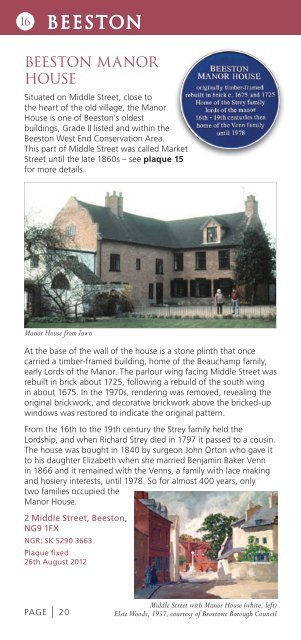GUIDE TO THE BLUE PLAQUES
BP%20final%20proof.2016.05.03
BP%20final%20proof.2016.05.03
Create successful ePaper yourself
Turn your PDF publications into a flip-book with our unique Google optimized e-Paper software.
BEES<strong>TO</strong>N<br />
BEES<strong>TO</strong>N<br />
16 17<br />
BEES<strong>TO</strong>N MANOR<br />
HOUSE<br />
Situated on Middle Street, close to<br />
the heart of the old village, the Manor<br />
House is one of Beeston’s oldest<br />
buildings, Grade II listed and within the<br />
Beeston West End Conservation Area.<br />
This part of Middle Street was called Market<br />
Street until the late 1860s – see plaque 15<br />
for more details.<br />
WEST END<br />
This short street in the Beeston West<br />
End Conservation Area boasts the<br />
largest concentration of listed buildings<br />
in Beeston – six in all.<br />
They include 16th to 18th century<br />
former farmhouses which, together<br />
with the Manor House on Middle Street<br />
(plaque 16), , are Beeston’s oldest houses,<br />
perhaps replacing even older buildings on the same sites. The oldest<br />
surviving, No. 6, West End House, dates from the 1560s and its<br />
occupants would have witnessed the deadly bubonic plague hitting<br />
Beeston in 1593. Centuries later its use changed from farmhouse<br />
to school, run first by Elizabeth Henshall in the late 19th century,<br />
followed briefly by Maud Mary Willett and then, for forty-four<br />
years up to 1947, by Miss Amy Eleanor Horner. Her name is still<br />
remembered by many.<br />
Manor House from lawn<br />
At the base of the wall of the house is a stone plinth that once<br />
carried a timber-framed building, home of the Beauchamp family,<br />
early Lords of the Manor. The parlour wing facing Middle Street was<br />
rebuilt in brick about 1725, following a rebuild of the south wing<br />
in about 1675. In the 1970s, rendering was removed, revealing the<br />
original brickwork, and decorative brickwork above the bricked-up<br />
windows was restored to indicate the original pattern.<br />
From the 16th to the 19th century the Strey family held the<br />
Lordship, and when Richard Strey died in 1797 it passed to a cousin.<br />
The house was bought in 1840 by surgeon John Orton who gave it<br />
to his daughter Elizabeth when she married Benjamin Baker Venn<br />
in 1866 and it remained with the Venns, a family with lace making<br />
and hosiery interests, until 1978. So for almost 400 years, only<br />
two families occupied the<br />
Manor House.<br />
2 Middle Street, Beeston,<br />
NG9 1FX<br />
NGR: SK 5290 3663<br />
Plaque fixed<br />
26th August 2012<br />
PAGE | 20<br />
Middle Street with Manor House (white, left)<br />
Elsie Woods, 1957, courtesy of Broxtowe Borough Council<br />
No.6, West End House<br />
No. 3, The Old Manor House, (not to be confused with the even<br />
older Middle Street Manor House), may be associated with a small<br />
Beeston manor owned by Wymondley Priory in Hertfordshire from<br />
the 12th to the 16th centuries.<br />
In all, a street of prestigious buildings bearing out that the<br />
wealthiest houses in any<br />
community tended to lie<br />
west of the centre, since<br />
the prevailing wind<br />
blew chimney smoke<br />
towards the east.<br />
1-3 West End,<br />
Beeston, NG9 1GL<br />
NGR: SK 5280 3654<br />
Plaque fixed<br />
5th November 2013<br />
No.3, Old Manor House from the garden<br />
PAGE | 21


